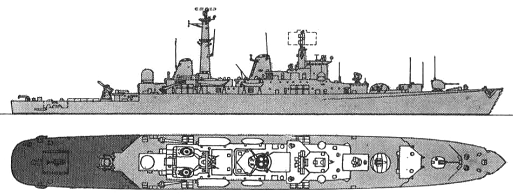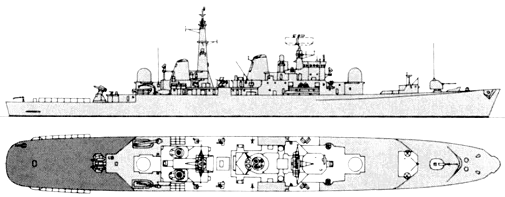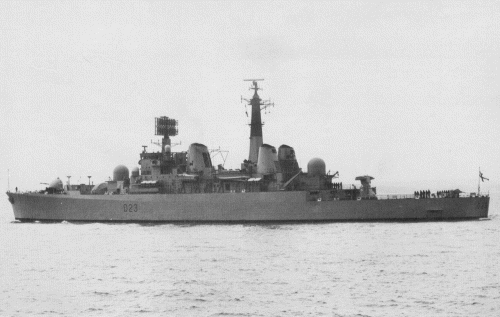

Bristol 1980

Bristol 1990
| Name | No | Yard No | Builder | Laid down | Launched | Comp | Fate |
| Bristol | D23 | Swan Hunter & Tyne SB, Wallsend | 15.11.1967 | 30.6.1969 | 31.3.1973 | training hulk 1993 |
|
Displacement standard, t |
6300 |
|
Displacement full, t |
7100 |
|
Length, m |
149.3 wl 154.5 oa |
|
Breadth, m |
16.8 |
|
Draught, m |
5.20 hull 7.00 sonar dome |
|
No of shafts |
2 |
|
Machinery |
COSAG: 2 sets Standard Range geared steam turbines, 2 Babcock & Wilcox boilers + 2 Bristol-Siddeley Marine Olympus TM1A gas turbines |
|
Power, h. p. |
30000+30000=60000 |
|
Max speed, kts |
30 |
|
Fuel, t |
oil + gas turbine oil 900 |
| Endurance, nm(kts) | 5000(18) |
|
Armament |
1 x 2 Sea Dart GWS30 SAM (40 Sea Dart), 1 x 1 Ikara GWS40 ASuM (32 Ikara), 1 x 1 - 114/55 Mk 8, 1 x 3 - 305 Limbo Mk 10 ASWRL, helicopter deck (for Wasp) |
|
Electronic equipment |
type 965 AKE-2, type 992Q, type 978, 2x type 909, 2x Ikara radars, type 162M, type 170M, type 184, type 189 sonars, type 670, UA-A1 ECM suites, 2x Corvus decoy RL, type 182 torpedo decoy, ADAWS-2 CCS |
|
Complement |
407 |
Project history: The new carriers planned for the 1970s would need escorts to provide them with anti-aircraft and anti-submarine defence and so four new DLGs were planned to follow the 'County' class. Although rated as DLGs, for some reason they were given Type No 82 in the general-purpose frigate series (originally known as CF299 frigates). With the cancellation of CVA-01 in 1966 it would have been logical to cancel them as well, and indeed the Board of Admiralty was willing to accept seven extra Leander class frigates in their place, but a trials ship had been promised for the Anglo-Netherlands 'Broomstick' radar pro-ject in the hope that the Netherlands would order the Olympus gas turbine. Finally, the class was cut back to one unit, the reason being that she could act as a trials ship for new weapons.
Although superficially resembling a 'cleaned-up' version of the 'County' class, the design incorporated another generation of equipment and ideas. The Sea Dart missile system used vertical stowage and a twin-arm zero-length launcher like USN systems, and is a semi-active beaming missile with a much greater capacity to handle multiple targets. Although the same type of COSAG machinery was adopted, much more attention was paid to providing good access to the gas turbines. The result was that the design changed from a single-funnel to a two-funnel configuration and finally to three funnels, the after uptakes being split into two separate funnels to allow access to the Olympus gas turbines. Bristol was thus the first RN ship to be designed around the new concept of upkeep by replacement, which reduces the time spent on machinery overhauls. Although nearly 1000t bigger than the 'Counties', she needed seventy men fewer to run her.
She was also the first RN ship to go to sea with the Anglo-Australian Ikara ASW missile system, mounted in a 'zareba' forward of the bridge. The new 4.5in Mk 8 gun in a Vickers mounting replaced the old Mk 6 twin, but only one was provided, in 'A' position. Work had been proceeding on a joint Anglo-Netherlands project to produce a Comprehensive Display System (CDS) radar for air warning, surveillance and aircraft direction, and it was to be mounted over the bridge, but the rising cost of research and development, combined with the belief that there would be no need for such a system because there would be no carrier-aircraft to direct, led to British withdrawing from the scheme. At the same time, the Netherlands was disenchanted with the spiralling cost (and volume) of the Sea Dart missile system; by mutual consent the CDS was dropped, and Bristol went to sea with the less capable Type 965 (AKE-2).
Although sometimes criticised as being a 'white elephant' she was an extremely versatile ship, with sophisticated command and communications to back up her weapon systems. The only serious shortcoming was the lack of a helicopter hangar, omitted because she was originally intended to operate with carriers. After completion she was used for weapon and system trials, and as a result never received the minor improvements given to other large ships.
The heart of Bristol's weapon systems was the Action Data Automation Weapon System Mk 2 (ADAWS-2), which coordinated data from the radar and sonar plots, the inertial navigation system, and any other source, and processed it via a suite of digital computers.
Modernizations: 1978: - 1 x 3 - 305 Limbo ASWRL, type 987 radar; + 2 x 1 - 20/70 Mk 7, type 1006 radar
1983: - type 670 ECM suite; + 2 x 2 - 30/75 GCM-A03, 2 x 1 - 20/90 GAM-B01, type 675 ECM suite, 4x Mk 36 SRBOC decoy RL
1986: - 1 x 1 Ikara ASuM, type 965 (AKE-2) radar, type 189 sonar; + type 1022 radar
Naval service: In 1973 the ship suffered serious, almost fatal, damage when her steam plant was virtually destroyed by fire. For a time it was feared that she would be scrapped, but she was able to complete the Ikara and Sea Dart trials programme running only on the two gas turbines. This helped to convince doubters about the wisdom of the change to all-gas turbine propulsion, and since then the steam plant has been repaired. She was intended to receive a big half-life modernization in 1981 but this was rescinded. She served for a while as a training ship.

Bristol 1981
© Ivan Gogin, 2016